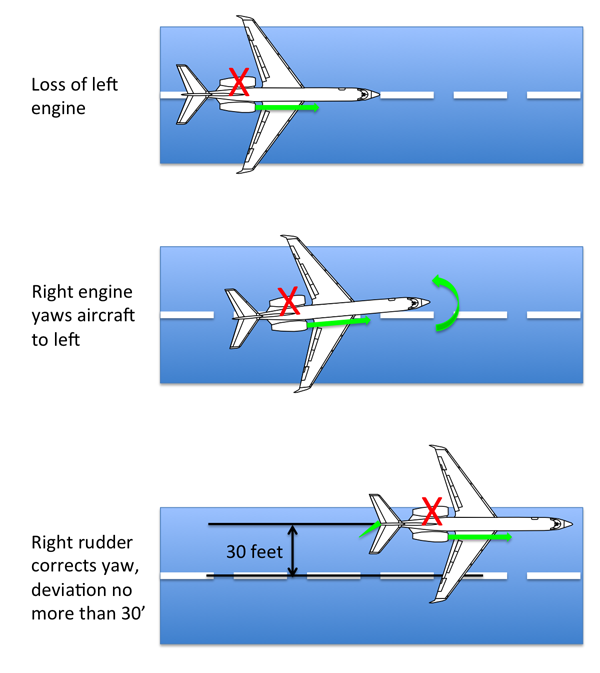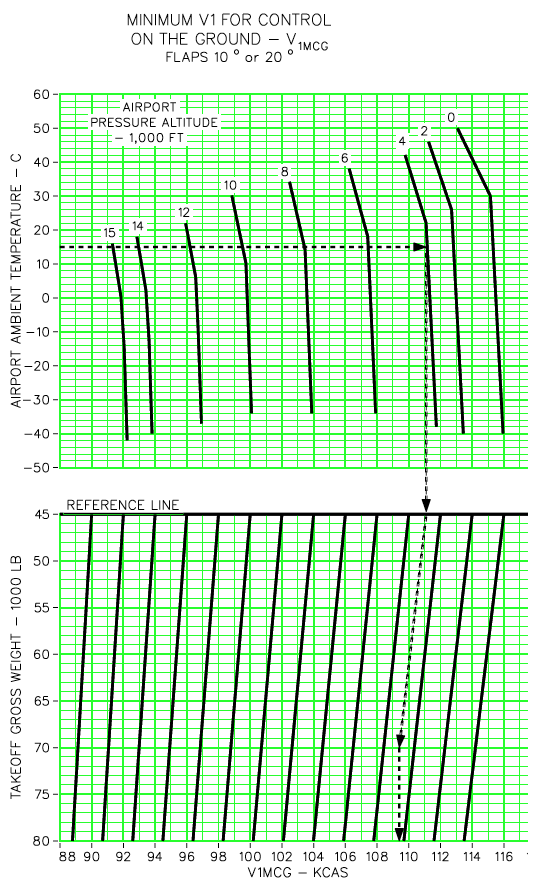In the old days we cared about the minimum control speed on the ground because we had to figure it for every takeoff and select our V1 using it and a handful of other numbers. Now that most of our takeoff data comes from a computer, that is done for us behind the scenes and knowing VMCG has become just another number you have to remember for your oral. But what does the number mean and is that number you recite every six months really what you think it is?
— James Albright

Updated:
2014-04-22
Having grown up in four engine airplanes, I reacted to the Gulfstream III's single number VMCG with skepticism but over the years have just accepted it as fact. Now, several years and several Gulfstreams later, I should be relearning my skeptical eye.

1
Regulatory
VMC means minimum control speed with the critical engine inoperative.
Source: 14 CFR 1.2
VMCG, the minimum control speed on the ground, is the calibrated airspeed during the takeoff run at which, when the critical engine is suddenly made inoperative, it is possible to maintain control of the airplane using the rudder control alone (without the use of nosewheel steering), as limited by 150 pounds of force, and the lateral control to the extent of keeping the wings level to enable the takeoff to be safely continued using normal piloting skill. In the determination of VMCG, assuming that the path of the airplane accelerating with all engines operating is along the centerline of the runway, its path from the point at which the critical engine is made inoperative to the point at which recovery to a direction parallel to the centerline is completed may not deviate more than 30 feet laterally from the centerline at any point. VMCG must be established with—
(1) The airplane in each takeoff configuration or, at the option of the applicant, in the most critical takeoff configuration;
(2) Maximum available takeoff power or thrust on the operating engines;
(3) The most unfavorable center of gravity;
(4) The airplane trimmed for takeoff; and
(5) The most unfavorable weight in the range of takeoff weights.
Source: 14 CFR 25.149 (e)
2
What it really means
Below VMCG you are relying on nosewheel steering to keep you on the runway, above this speed you are relying on the aerodynamics of the airplane to keep you going straight after no more than a 30 foot excursion from centerline. VMCG will vary with aircraft thrust, weight, temperature, and pressure altitude.
3
Gulfstream example
Gulfstream complicates things a bit:
Minimum control Speed Ground (VMCG): 109 KCAS
Source: Gulfstream G450 Airplane Flight Manual, §1-03-40
The chart, however, shows a range of what Gulfstream calls V1MCG, the minimum V1 for control on the ground.
Source: Gulfstream G450 Airplane Flight Manual, §5.5-10
The G450 pilot should understand that the published VMCG, 109 KCAS, is probably not an accurate number for any given takeoff. It is probably "about right," but your V1 will always be at least VMCG so you should never rotate before V1 because your control on the ground before this speed depends on nosewheel steering.
References
(Source material)
14 CFR 1, Title 14: Aeronautics and Space, Definitions and Abbreviations, Federal Aviation Administration, Department of Transportation
14 CFR 25, Title 14: Aeronautics and Space, Airworthiness Standards: Transport Category Airplanes, Federal Aviation Administration, Department of Transportation
Gulfstream G450 Airplane Flight Manual, Revision 35, April 18, 2013
Please note: Gulfstream Aerospace Corporation has no affiliation or connection whatsoever with this website, and Gulfstream does not review, endorse, or approve any of the content included on the site. As a result, Gulfstream is not responsible or liable for your use of any materials or information obtained from this site.

